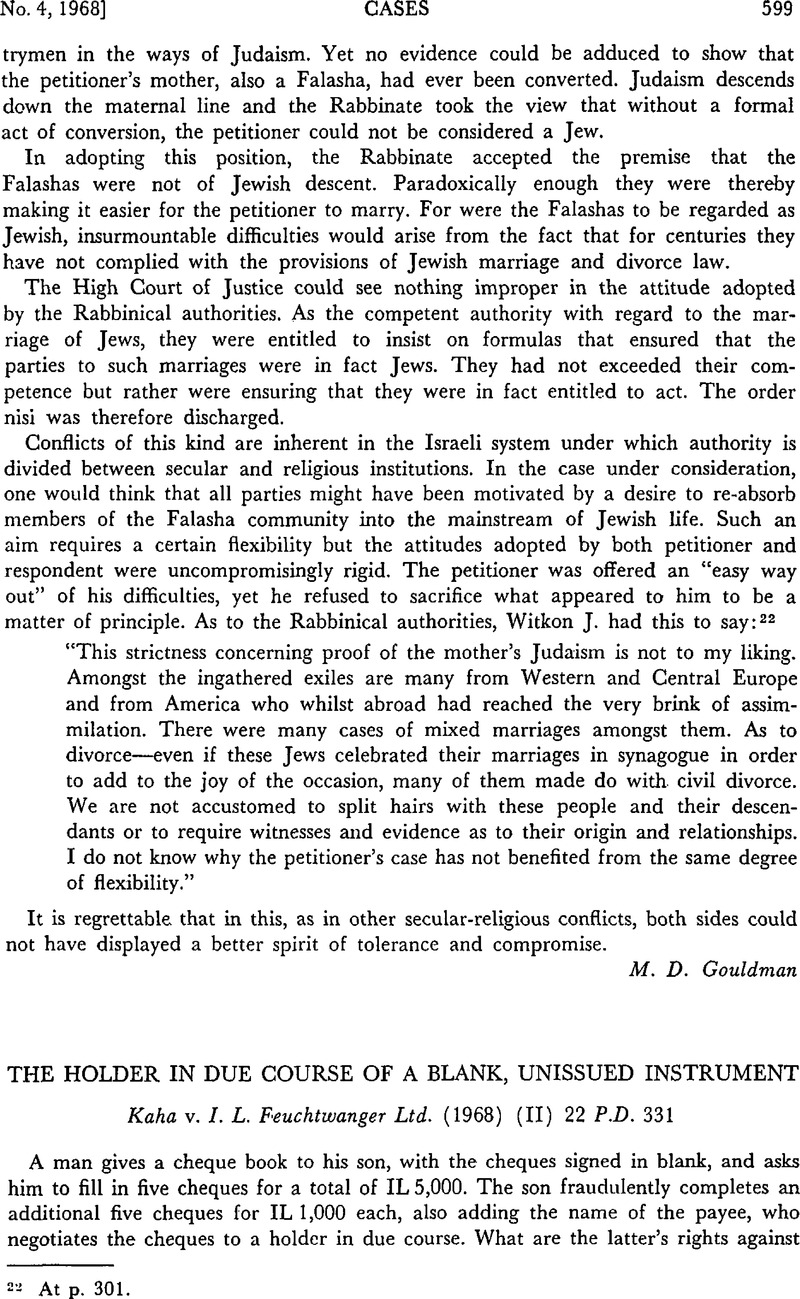No CrossRef data available.
Article contents
The Holder in Due Course of a Blank, Unissued Instrument
Published online by Cambridge University Press: 12 February 2016
Abstract

- Type
- Cases
- Information
- Copyright
- Copyright © Cambridge University Press and The Faculty of Law, The Hebrew University of Jerusalem 1968
References
1 Sec. 19(b) of the Ordinance.
2 Sec. 20(b) of the Ordinance.
3 See Baxendale v. Bennett (1878) Q.B.D. 525; Smith v. Prosser [1907] 2 K.B. 735.
4 See Hubert v. Home Bank of Canada (1910) 20 O.L.R. 651; Mackenty v. Vanhonenback (1911) 21 Man. R. 360; Cambell v. Bourque (1914) 17 D.L.R. 262.
5 See Herbert v. Steele, 1953(3) S.A. 271 (T).
6 See Ryley, , Bills of Exchange in Australia, 78Google Scholar.
7 The Kaha case. This was also the view of Sussmann, J. in his book Bills of Exchange Law (4th ed., Hebrew) sec. 83, p. 107Google Scholar, before the Kaha case, which relied on the book.
8 See Sussmann, op. cit., sec. 82, p. 107.
9 For other problems in the wake of this omission see Sussmann, op. cit., secs. 122 ff., p. 157 ff.
10 Sec. 19(a) of the Ordinance.
11 The concluding part of sec. 20(b) of the Ordinance.
12 This is the case of sec. 19 itself, see Sussmann, op. cit., sec. 123, p. 158.
13 See the General Trust for Palestine v. Braude (1952) 6 P.D. 1147, 1169 following— wrongly I think—McDonald v. Nash [1924] A.C. 625, 648. See also Schwarz v. Zurkis (1962) 16 P.D. 1300, 1302.
14 Most authors textually repeat the case of Baxendale v. Bennett (supra). A scrutiny of the Baxendale case fails to disclose a rational basis for the decision.
15 Sussmann, op. cit., sec. 82, p. 107.
16 See Chalmers, , Bills of Exchange (2nd ed., 1881) 47–48Google Scholar.
17 Sussmann, op. cit., sec. 83, p. 108.
18 See Britton, ‘Defences, Claims of Ownership and Equities—A Comparison of the Provisions of the Negotiable Instrument Law with Corresponding Provisions of Article 3 of the Commercial Code” (1955) 7 Hastings L. J. 1, 12.
19 As to which see below.
20 Sussmann, op. cit., sec. 83, p. 108.
21 Ibid.
22 Per Sussmann J. in Heruti v. Shubes (1964) (I ) P.D. 403, 411.
23 See Britton, , Bills and Notes (2nd ed., 1961) 209Google Scholar: “if a person signed his name on a blank piece of paper and tossed it into the street where it was picked up, a note or cheque written above it, and the instrument negotiated to a holder in due course, it would seem most improbable that such signer would be estopped from setting up the defence of non-delivery. For a case to be within the estoppel modification of section 15, there must be, in addition to the signature, recitals of the formal requisites of negotiability sufficient to indicate that the signer, at the time he signed, contemplated the use of such writings as a negotiable instrument.”
24 Sussmann, op. cit., sec. 203, p. 253.
25 Ibid. 251.
26 [1907] 2 K.B. 735.
27 See in particular the Canadian cases cited in n. 4 above.
28 See Russel, , A Commentary on the Bills of Exchange Act (2nd ed., 1921) 130Google Scholar, quoted in Falconbridge, The Law of Banks and Banking, Bills, Cheques and Notes (6th ed., 1956) 526Google Scholar.
29 See also the explanatory note to the U.C.C., quoted below in the text over n. 36.
30 1926 T.P.D. 141.
31 Ibid., 146.
32 Hawkland, , Commercial Paper (1959) 77Google Scholar: “The rule is a strange one, because neither non-delivery nor unauthorized completion standing alone is treated as a real defense. Just why the two together should constitute such a defense is not clear.”
33 Sussmann, op. cit., sec. 82, p. 107, quoting sec. 15 of the N.I.L.
34 See Britton, , Bills and Notes (2nd ed., 1961) 204 f.Google Scholar
35 Sec. 3–115 of th e U.C.C: “(2) If the completion is unauthorized the rules as to material alteration apply (Section 3–407), even though the paper was not delivered by the maker or drawer” (emphasis added). Sec. 3–407, sub-sec. 3 provides: “A subsequent holder in due course may in all cases enforce the instrument according to its original tenor, and when an incomplete instrument has been completed, he may enforce it as completed.”
36 See Uniform Commercial Code, 1962, Official Text 247.
37 See Hawkland, op. cit., 77; Britton, “Defense Claims of Ownership and Equities”, op. cit., 12.
38 As to the nature of the distinction, see my article “Forgery in the Drawing of a Cheque: Objects and Means of the Distribution of Risk Between the Bank and the Customer” (1968) Mishpatim 134 (Hebrew).
39 Ibid.
40 See Britton, , Bills and Notes 206Google Scholar. A distinction may be found in the American cases between the signer's duty towards the drawer bank an d his duty towards a holder in due course. Although the duty is readily admitted in the case of the drawer and the drawee bank, some difficulties arose in recognizing the duty owed by the signer to the holder in due course. I do not see the relevance of this distinction. The existence of a contract (in the first case) or its absence (in the second) does not justify, in terms of the law of torts, the recognition of the duty to take care in one case and its denial in another.
41 As regards the U.C.C., see sec. 4–402(2).
42 See my paper “The Uniform Commercial Code—Commercial Paper” (1968) 3 Is.L.R. 184, 199ff.Google Scholar


